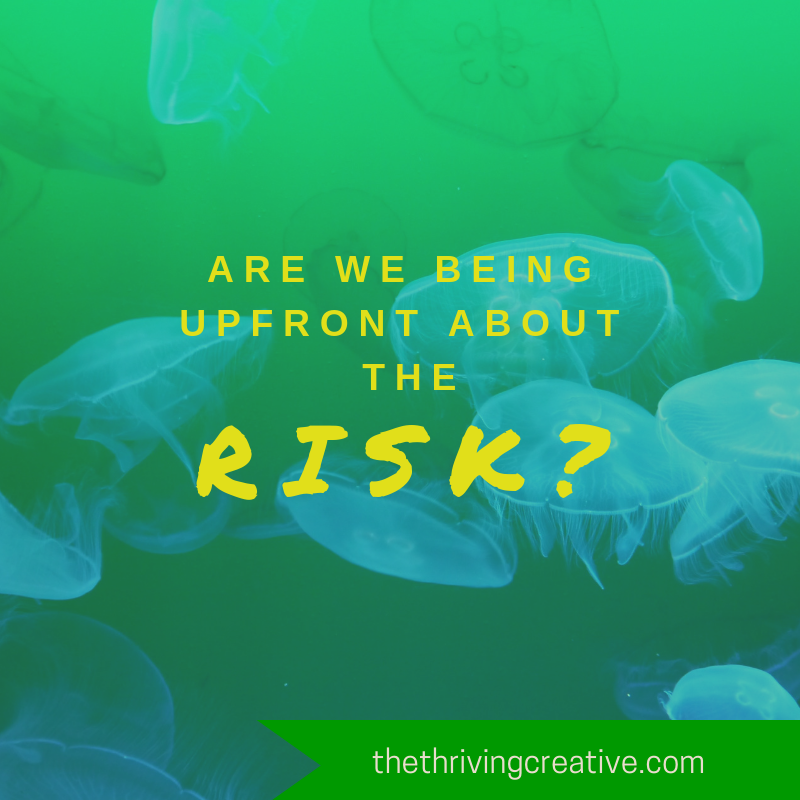
Today I paid a visit to the bank to sit with an advisor. My current work as a part-time Professor at a college does not have a pension scheme and I wanted to open up an investment vehicle in which I could stash a few dollars each month towards buying myself diapers and gin in my dotage.
We decided that I would open a TFSA which would invest money in mutual funds. Meaning, I was going to be putting money into the stock market.
What was fascinating to me is the number of hoops I had to jump through in order to do this.
We went through a lengthy questionnaire to determine my ‘risk appetite’ and also my ‘investment horizon’.
There were lots of questions like was I looking to generate an income from this investment or was I looking for long term growth? Was I hoping to match or beat inflation?
And crucially, how much money was I willing to lose?
In other words, they were VERY explicit that buying shares traded on the stock market comes with risk. While we can look at historical performance, they pointed out repeatedly that this was no indication of future performance and was I aware that I could end up with less money than I was putting in?
Once we had narrowed down a fund relative to my risk appetite, we then looked at the fund’s performance for the last ten years. They pointed out that in 2008, when the Global Financial Crisis happened, the fund lost 23.4%. On its best year, 2013, it made 18% profit. And how over ten years it had an average performance of 6.6%.
I found this transparency remarkable. And it demonstrates how regulation can be applied to educating consumers.
I was struck by the fact that when I used to sit in a hall on ‘Open Days’ at a previous University, my colleagues and I would try to compete with each other to ‘sell’ our degree programmes to potential students and their parents.
We would outline all the fantastic courses and learning opportunities they would get. We would look at a few testimonials from students about all that they got from their education and we would highlight a few star graduates who had gone on to achieve fantastic things.
I did try to give a rounder representation and spoke about the broader outcomes of graduates including working in box offices, going into teaching jobs, etc. And while the University trotted out data about how 98% of their graduates were in employment within 6 months of graduating, we never really gave any concrete figures of WHAT that employment actually was.
Now, I am not a philistine and I do not think that education doesn’t have all kinds of wonderful value that you can’t put a price tag on.
However, the care with which the bank walked me through investing a small amount of money into a mutual fund — especially highlighting the financial risk of this investment — is not equalled in the education market.
UK tuition, where I was teaching, was £9,250 per year for a 3-year course. Plus £12,000- 20,000 per year living expenses to be in London for three years means the average student was taking on about £50-60,000 debt for a course in the performing arts.
Where the ‘return on their investment’ in purely financial terms was probably pretty low.
There was some research in the UK (ISF, 2016) that showed that a male student going into a creative subject degree will earn less over their lifetime than if they never went to University at all. That figure is only taking into account extrinsic reward from their work and not intrinsic reward, so the creative graduate might earn less over their lifetime but enjoy their work a lot more, which of course has value… but when considering the investment in the first place, should this not be spelled out for them so the consumer can make an informed choice?
Is it a case of ‘buyer beware’ and the onus rests on the student and his/her parents to fully research the possible outcomes in order to make an informed choice?
Or should education, like finance, have to be much more explicit about the ‘return on investment’ that their particular degree might bring?
I am sure some people will be riled by this and think that I am undermining the value of a creative degree. Or the value of going into a creative field of work.
I do not say this lightly. I have spent my life working in the creative industries and there are many wonderful things about them.
However, we need to start being a lot more honest about who can afford to work in these industries, on low wages (or no wages) and what other forms of subsidy they have.
This is a much bigger topic, that I will continue to explore. But to end today’s lesson – the care, caution and thoroughness with which the banking industry held my hand today and walked me through my various investment possibilities, and the risk that they carry, is, I believe, something we need to consider in the education field.
How much risk are you willing to take on? What is your risk appetite? Are you aware of the risks, not just the potential rewards, of putting your money on this educational path? That’s the honest discussion that I feel is missing and that the educational institutions perhaps don’t wish to have.
Leave a Reply